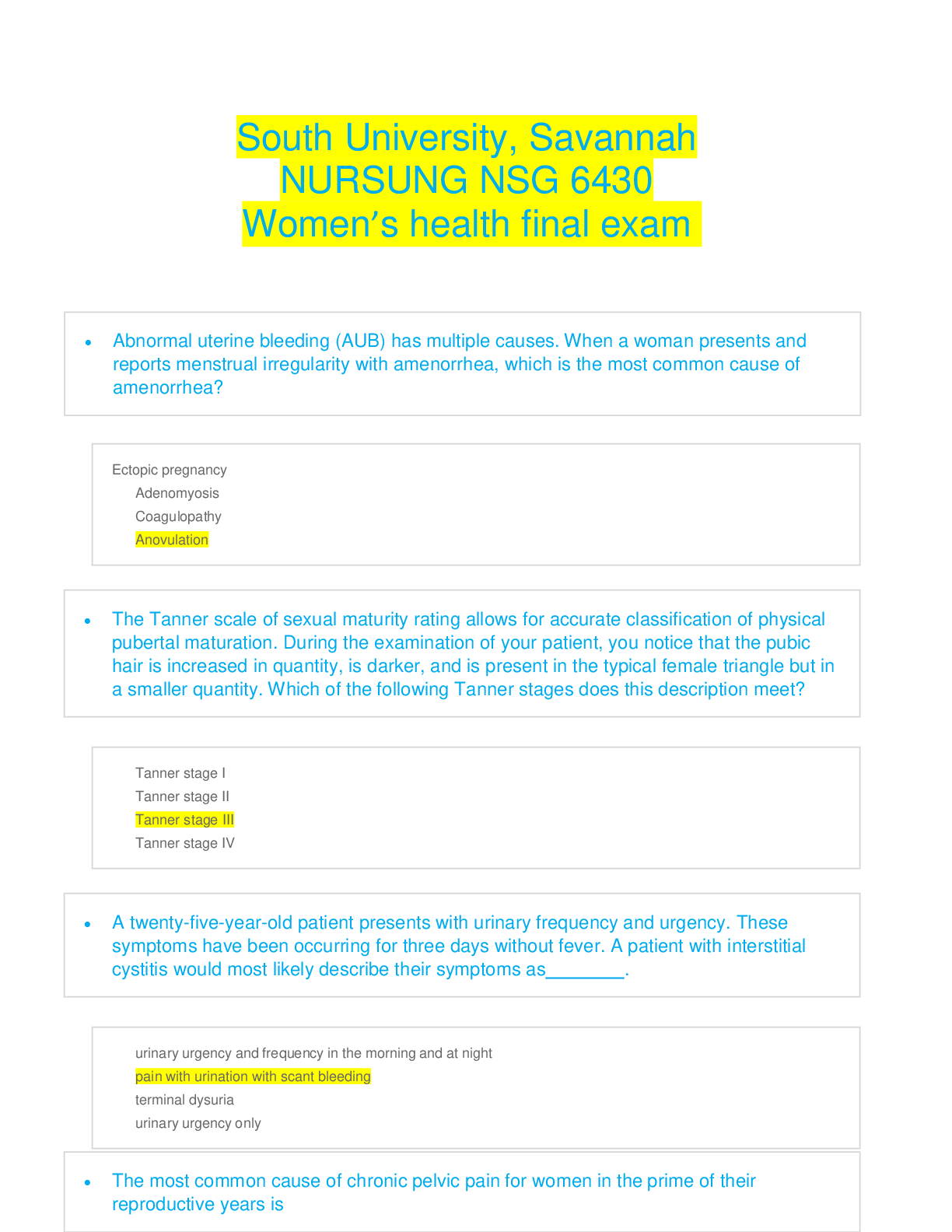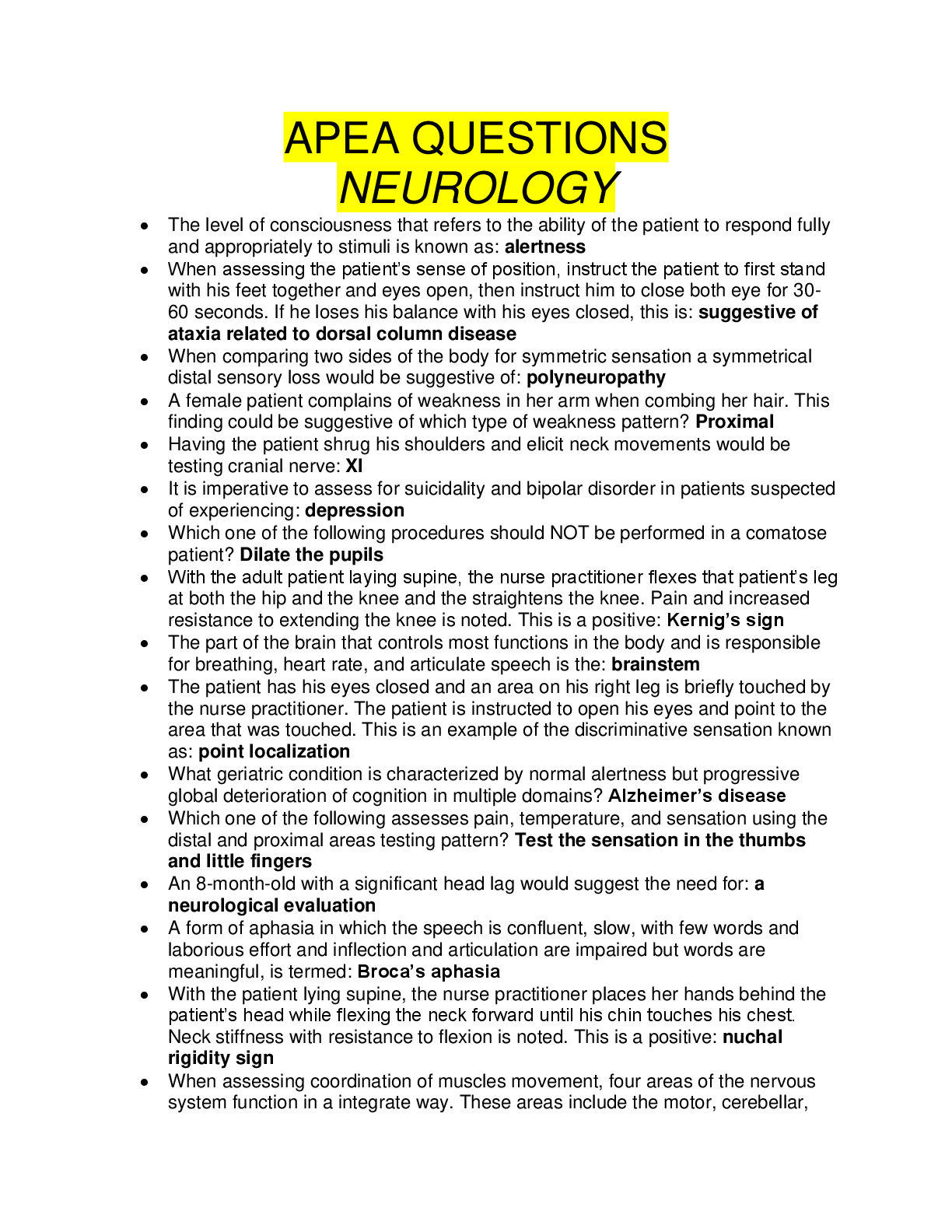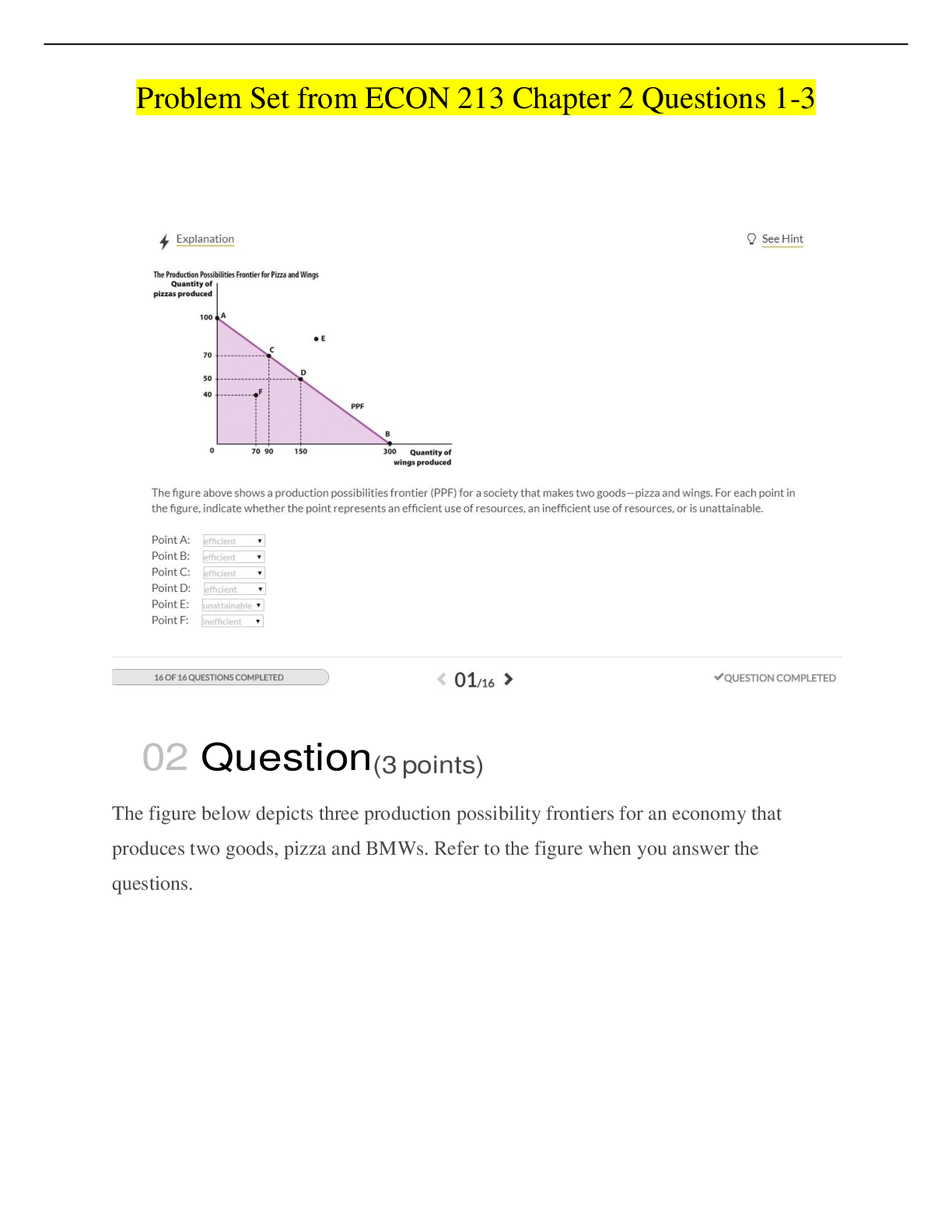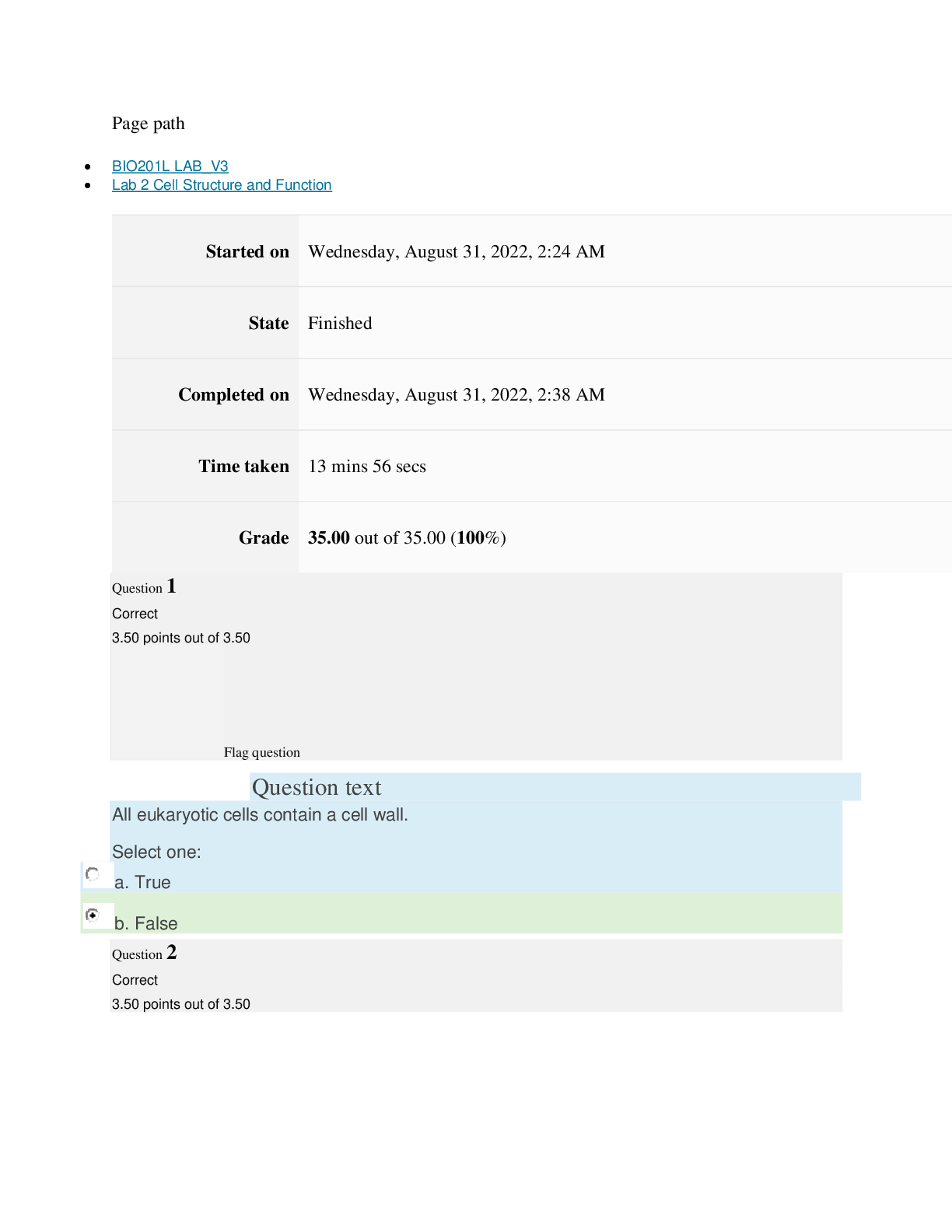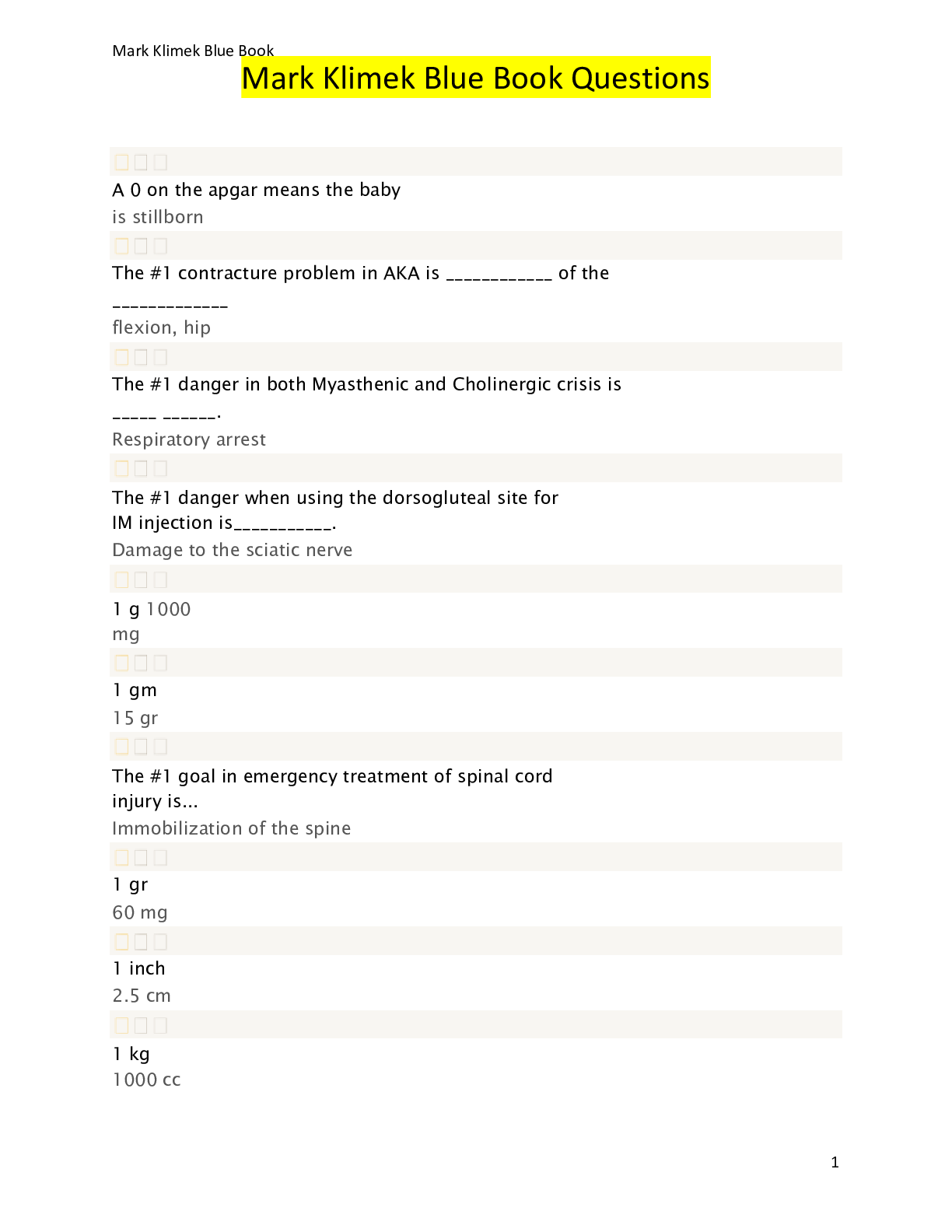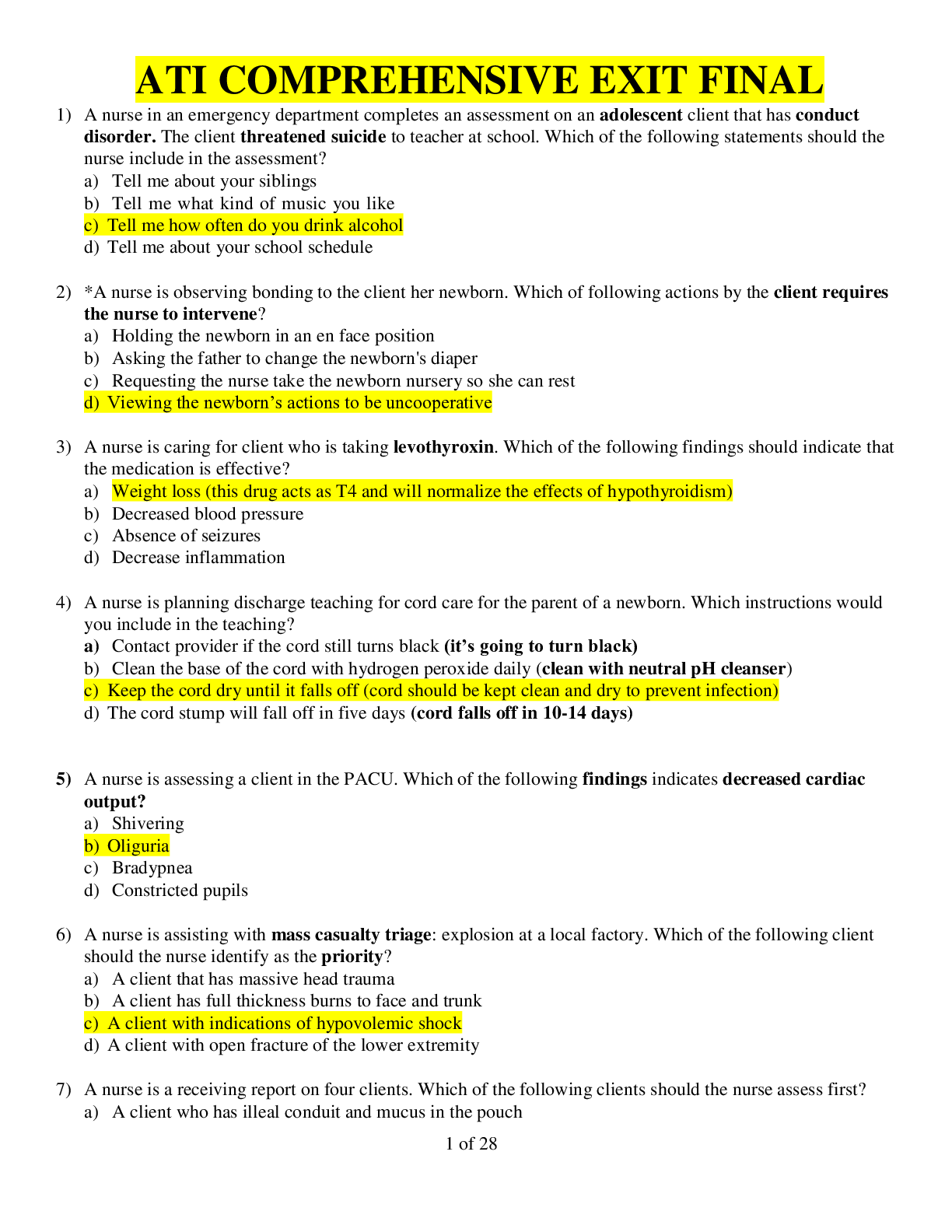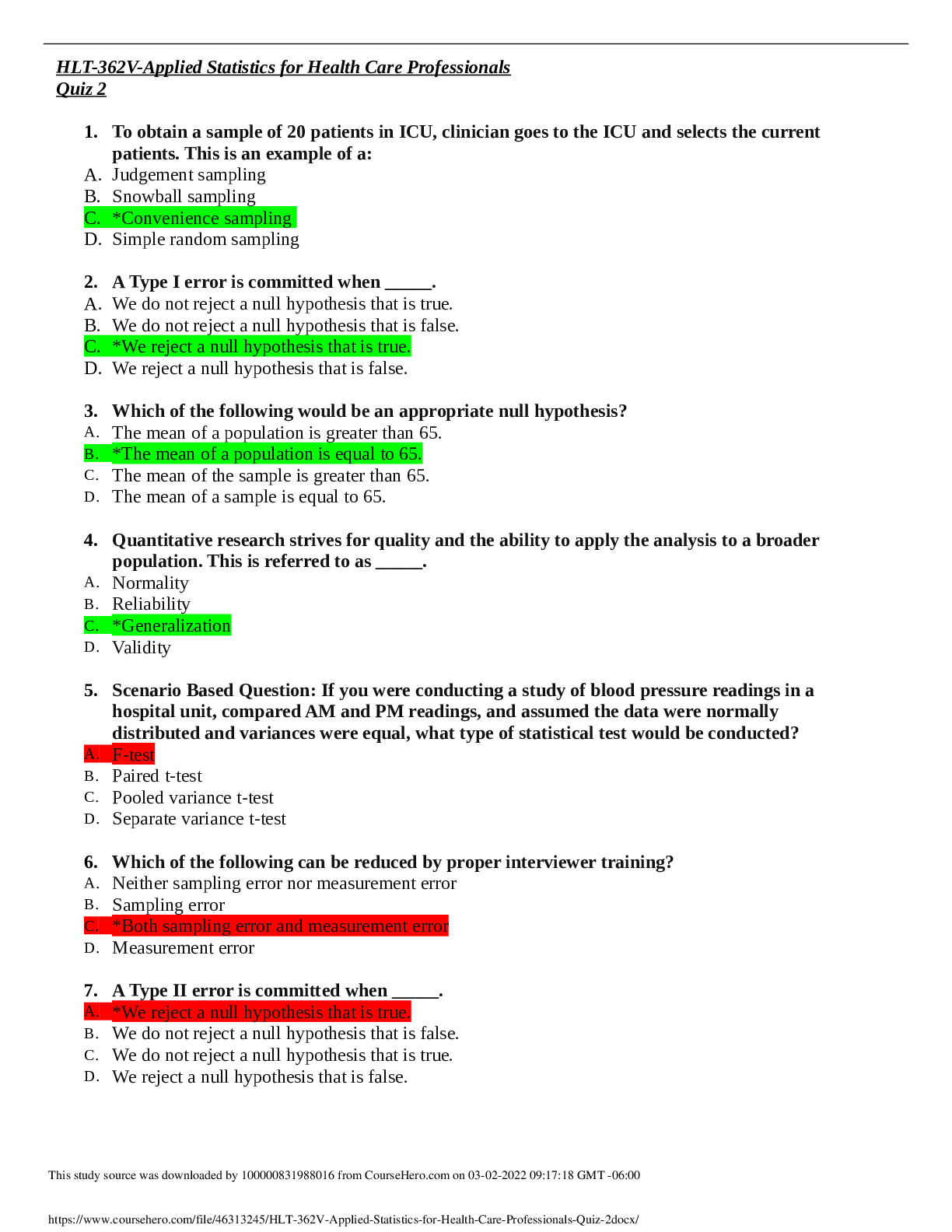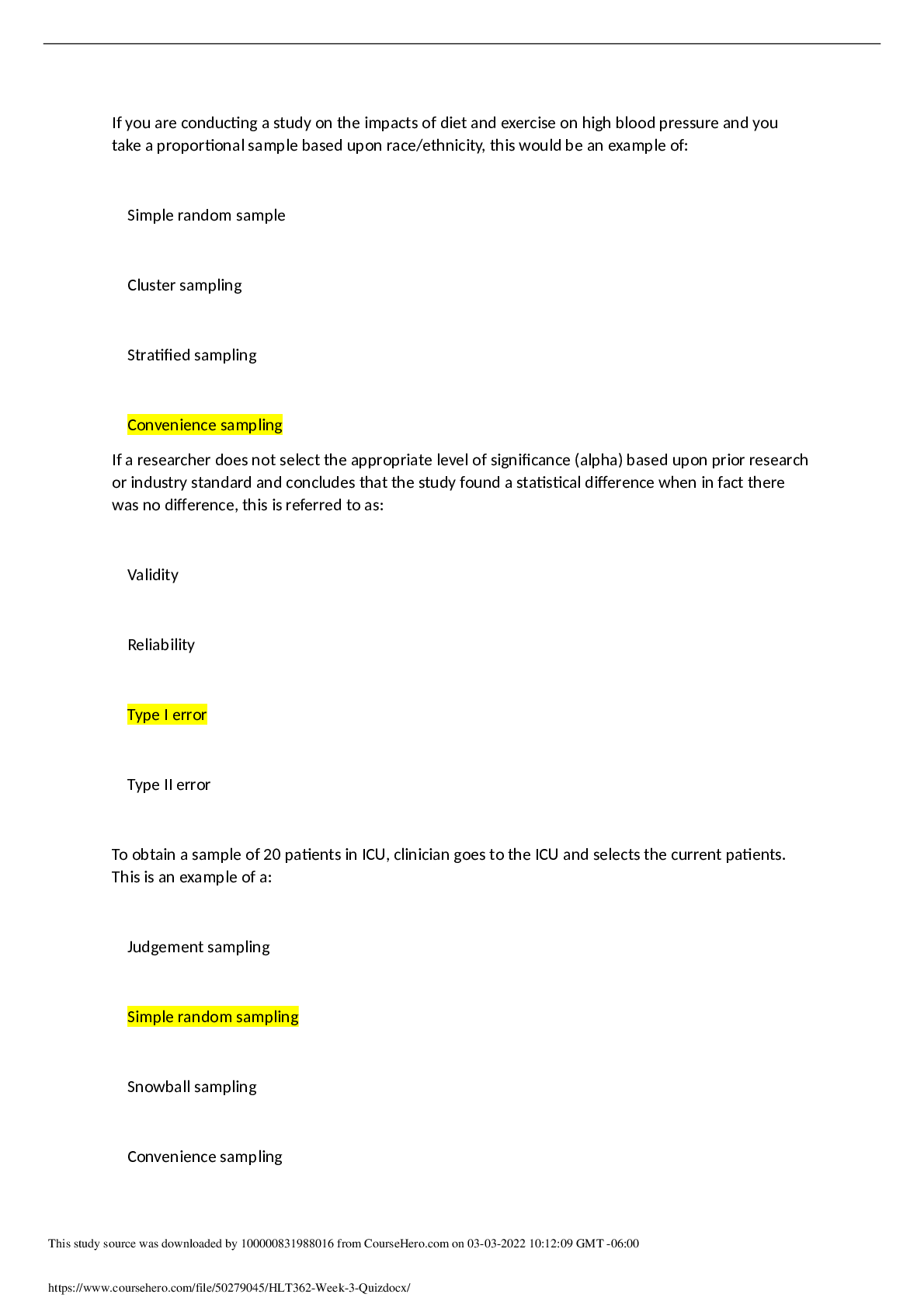*NURSING > QUESTIONS & ANSWERS > Capscare Academy for Health Care Education Inc. - NURSING 1234 (ALREADY GRADED A) (All)
Capscare Academy for Health Care Education Inc. - NURSING 1234 (ALREADY GRADED A)
Document Content and Description Below
Chapter 03: Care of the Patient with an Integumentary Disorder 1)A patient has generalized macular-papular skin eruptions and complains of severe pruritus from contact dermatitis. When the nurse admi... nisters his therapeutic bath, it is important to remember that 2)A patient, age 63, has cancer of the left breast. After a modified radical mastectomy, she has been receiving chemotherapy. Her grandson, who visited a few days ago, now has varicella (chickenpox). The nurse should observe her carefully for signs of 3. A patient has herpes zoster (shingles). A local antiviral agent, which is useful in delaying the progression of herpetic diseases, was prescribed. This medication is 4. A child has been sent home from school with pruritus and honey-colored crusts on his lower lip and chin. A probable diagnosis would be 5. A patient has an erythematous patch of vesicles on her scalp, and she complains of pain and pruritus. A diagnosis of tinea capitis is made. The causative organism is 6. A patient, age 46, reports to his physician's office with urticaria and papules on his hands and arms. He says, "It itches so badly." In assessing the patient, the nurse should 7. A patient has been receiving penicillin, acetaminophen with codeine, and hydrochlorothiazide for 4 days. He now has a urinary tract infection. A sulfonamide has been prescribed to be taken three times per day. Several hours after the second dose , he complains of pruritus. The nurse observes a generalized erythema and rash. The most appropriate nursing intervention would be 8. A patient has acne vulgaris. When the nurse explains this condition, it is most important to 9. A 30-year-old African American had surgery 6 months ago. Her incisional site is now raised, indurated, and shiny. This tissue growth is most likely a(n) 10. A patient, age 37, sustained partial- and full-thickness burns to 26% of her body surface area. The greatest fluid loss resulting from her burns will usually occur11. Most of the deaths from burn trauma in the emergent phase that require a referral to a burn center result from 12. A patient, age 26, is admitted to the burn unit with partial- and full-thickness burns to 20% of his body surface area as well as smoke-inhalation injury. Carbon monoxide intoxication secondary to smoke inhalation is often fatal because carbon monoxide 13. A nurse arrives at an accident scene where the victim has just received an electrical burn. The nurse's primary concern is 14. A patient, age 27, sustained thermal burns to 18% of her body surface area. After the first 72 hours, the nurse will have to observe for the most common cause of burn-related deaths, which is 15. A duodenal ulcer may occur 8 to 14 days after severe burns. Usually, the first symptom is bright red emesis. Which condition matches this description? 16. A nurse is providing the open method of treatment for a patient who is 52 years old with burns to her lower extremities. It would be important for the nurse to 17. The nurse has initiated measures to promote suppuration of a carbuncle. Which assessment would indicate that these measures have been successful? 18. A patient, age 20, is admitted with severe eczema. In planning the care for her, the nurse should plan to 19. The nurse is caring for a 26-year-old patient who was burned 72 hours ago. He has partial-thickness burns to 24% of his body surface area. He begins to excrete large amounts of urine. The nurse should 20. A patient, age 29, is diagnosed with genital herpes. She is receiving acyclovir (Zovirax). Which would indicate a therapeutic response? 21. A female patient is seen by the school nurse because of flat lesions that are clear in the center with erythematous borders. In assessing a patient for tinea corporis, the nurse would check 22. A patient has been walking in the woods. He complains of severe pruritus. The nurse notes an erythematous area on his lower legs. The first nursing intervention for dermatitis venenata would be to 23. The nurse debriding a wound explains the purpose of debridement is to: 24. A patient has been admitted to the hospital with burns to his upper chest. The nurse notes singed nasal hairs. It would be important for the nurse to assess this patient frequently for 25. Which may indicate a malignant melanoma in a nevus on a patient's arm? 26. A dark-skinned patient has been admitted to the hospital in severe respiratory distress. To determine whether the patient is cyanotic, the nurse uses what knowledge of skin assessment? 27. A patient developed a severe contact dermatitis of her hands, arms, and lower legs after spending an afternoon picking strawberries. She states that the itching is severe and she cannot keep from scratching. Which instruction by the nurse will be most helpful in managing the pruritus? 28. A patient is a 32-year-old woman whose mother recently died from malignant melanoma. She asks the nurse about what she can do to prevent the development of malignant melanoma in herself and her children. The best response by the nurse includes which information regarding risk factors for melanoma?29. In addition to medication management of systemic lupus erythematosus, which supportive therapy would help control the disease? 30. Cellulitis is a potentially serious infection. In adults Staphylococcus aureus can cause which complications? 31. Nursing interventions for treatment of herpes virus infections are: 32. Parasitic skin diseases are identified as pediculosis or scabies. The difference between pediculosis and scabies is 33. Melanocytes give rise to the pigment melanin which is responsible for skin color. The melanocytes can be found in 34. The three major glands of the skin are __________, ___________, and __________.35. The most deadly skin cancer is ________________. Chapter 2 1. How does palliative surgery differ from any other type of surgery? A. The main purpose is cosmetic in nature rather than functional repair or comfort. B. There are fewer risks associated with palliative surgery than with any other type of surgery. C. The outcomes of palliative surgery cannot be ensured to produce the desired effect or restoration of functional ability. D. Palliative surgery is performed to provide temporary relief of distressing symptoms rather than to cure a problem or condition. 2. The client tells the nurse during the preoperative history that he is a three-pack a day cigarette smoker. This information alerts the nurse to which potential complication during the intraoperative and postoperative periods? A. A decreased tolerance to pain B. A decreased clotting ability C. An increased risk for atelectasis and hypoxia D. An increased risk for excessive scar tissue formation 3. The client receiving preoperative medication tells the nurse that all of the following medications (drugs or herbs) were ingested yesterday. Which one should the nurse report to the surgical team? A. Acetaminophen (Tylenol) B. Vitamin C C. Motherwort D. Diphenhydramine (Benadryl) 4. When the nurse brings the preoperative medication to the client about to have abdominal surgery, she tells the nurse that she does not need the injection because she had a good night's sleep last night. What is the nurse's best first action? A. Tell the client that her surgeon has ordered the medication; therefore, she should go ahead and take the medication because the surgeon knows what is best. B. Tell the client that the preoperative medication is ordered to reduce the risk of some problems during surgery rather than to ensure adequate rest. C. Appropriately discard the preoperative medication and notify the surgeon. D. Document the client's statement and notify the charge nurse. 5. The client who is scheduled to have surgery cannot read or write. The surgeon obtaining the consent wants to have the client's spouse sign the consent instead. What is the nurse's best action? A. Nothing; a signed informed consent statement does not need to be obtained from this client. B. Locate the spouse, because the informed consent statement must be signed by the client's closest relative. C. Inform the surgeon that the client may sign the informed consent statement with an X in front of two witnesses. D. Notify the administration because the court must appoint a legal guardian to represent the client's best interests and give consent for all surgical procedures. 6. Twenty minutes after the client has received a preoperative injection of atropine and midazolam (Versed), the client tells the nurse that he must be allergic to the medication because his mouth is dry and his heart seems to be beating faster than normal. What is the nurse's best first action? A. Document the findings as the only action. B. Check the client's pulse and blood pressure. C. Prepare to administer epinephrine and diphenhydramine (Benadryl). D. Explain to the client that these symptoms are normal responses to the medication. 7. Which nursing action or statement is most likely to reduce anxiety in a client being brought to the surgical suite? A. Asking the client if he or she has talked with the hospital chaplain B. Asking the client what specific surgery he or she is having done today C. Asking the client if he or she wants family members to be with them in the holding area D. Explaining to the client that the surgical area is the most technologically advanced in the city 8. All of the members of the surgical team must perform a "surgical scrub" except which of the following? A. Anesthetist/anesthesiologist B. Surgical technologist C. Scrub nurse D. Surgeon 9. In the operating room, the client tells the circulating nurse that he is going to have the cataract in his left eye removed. The nurse notes that the consent form indicates that surgery is to be performed on the right eye. What is the nurse's best first action? A. Assume that the client is a little confused because he is older and has received midazolam intramuscularly. B. Check to see if the client has received any preoperative medications. C. Notify the surgeon and anesthesiologist. D. Ask the client his name. 10. The anesthetized client with an open abdomen suddenly develops malignant hyperthermia. What intervention should the nurse be prepared to initiate or assist with? A. Discontinue mechanical ventilation. B. Administer intravenous potassium chloride. C. Administer intravenous calcium chloride. D. Administer intravenous dantrolene (Dantrium). 11. What is the priority nursing diagnosis for the client under general anesthesia during surgery? A. Acute Pain related to surgical procedure B. Risk for Infection related to surgical wound C. Risk for Impaired Skin Integrity related to prolonged static position D. Disturbed Body Image related to presence of surgical wound or scar 12. The client who has received ketamine hydrochloride during a surgical procedure has all of the following manifestations and behaviors. Which one alerts the nurse to a dissociative reaction? A. Hypoventilation and decreased oxygen saturation B. Presence of hives on the skin around the IV site C. Crying because the pain at the surgical site has increased D. Pulling out the IV because he sees bugs in the solution bag 13. Who is responsible for accompanying the surgical client to the postanesthesia recovery area after surgery and for giving a report of the client's intraoperative experience to the PACU nurse? A. The surgeon and scrub nurse B. The surgeon and circulating nurse C. The anesthesiologist and scrub nurse D. The anesthesiologist and circulating nurse 14. The client is admitted to the postanesthesia care unit (PACU) after surgery that took place with the client in the lithotomy position. Which change in assessment findings alerts the nurse to a possible complication of this surgical position? A. The electrocardiogram (ECG) shows tall, peaked T waves and wide QRS complexes. B. The client only arouses in response to light shaking. C. The pulse pressure has increased from 28 to 40 mm Hg. D. The dorsalis pedis pulses are not palpable bilaterally. 15. Which client is at greatest risk for respiratory complications after surgery under general anesthesia? A. 65-year-old woman taking a calcium channel blocker for hypertension B. 55-year-old man with chronic allergic rhinitis C. 45-year-old woman with diabetes mellitus type 1 D. 35-year-old man who smokes two packs of cigarettes daily , the nurse auscultates the client's abdomen. No bowel sounds are present. What is the nurse's best first action? A. Position the client on the right side with the bed flat. B. Check the dressing and apply an abdominal binder. C. Palpate the bladder and measure abdominal girth. D. Document the finding as the only action. 17. Calculate the actual amount of nasogastric (NG) tube drainage during an 8-hour shift (3 PM to 11 PM) from the client who has a drainage container with 200 mL marked at 3 PM and 840 mL at 11 PM, and who received NG irrigations (flushings) of 60 mL three times during the 8-hour shift. A. 840 mL B. 660 mL C. 460 mL D. 420 mL 18. The client who is 24 hours postoperative from abdominal surgery has light brown fluid with small particles that look like coffee grounds in the NG tube drainage. What is the nurse's best action? A. Notify the physician. B. Irrigate the tube with normal saline. C. Clamp the tube and advance it 1 to 2 inches. D. Document the finding as the only action. 19. The nurse empties 80 mL of sanguineous drainage from the Jackson-Pratt drain in the client's hip after hip surgery. What other actions regarding the drain should the nurse take? A. Flush the tubing with urokinase to ensure patency. B. Compress and close the drain to ensure suction. C. Advance the tubing ½ inch from the insertion site. D. Clamp the drain for 2 hours and release the clamp for 2 hours. 20. The client is postoperative from surgery performed to determine whether a growth in her colon is cancerous. She asks the nurse what the pathology report shows. The pathology report indicates that the growth is benign. What is the nurse's best response? A. "Congratulations! The growth was not cancerous." B. "You will have to wait for your doctor to tell you the results." C. "You shouldn't worry. Most tumors of this sort are benign." D. "I will call your doctor to let her know you are awake and are concerned about the results." [Show More]
Last updated: 2 years ago
Preview 1 out of 9 pages
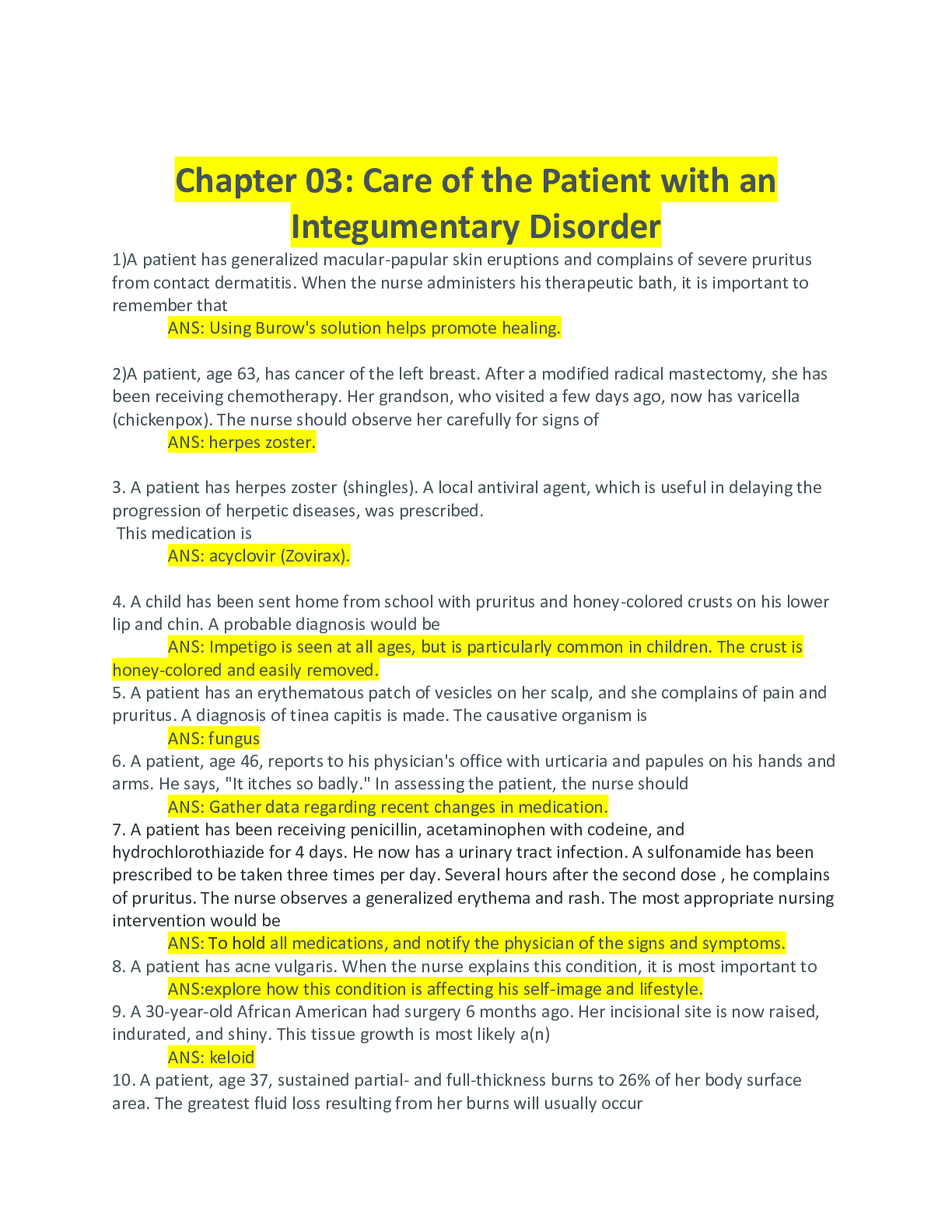
Buy this document to get the full access instantly
Instant Download Access after purchase
Buy NowInstant download
We Accept:

Reviews( 0 )
$18.00
Can't find what you want? Try our AI powered Search
Document information
Connected school, study & course
About the document
Uploaded On
Apr 11, 2020
Number of pages
9
Written in
Additional information
This document has been written for:
Uploaded
Apr 11, 2020
Downloads
0
Views
57

